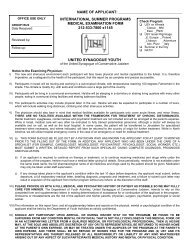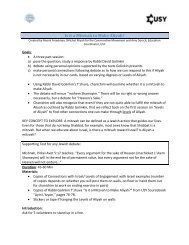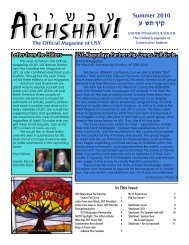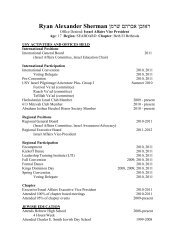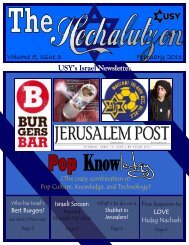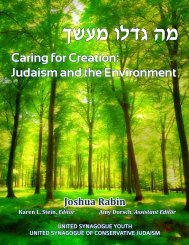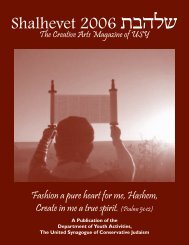Lesson Plan âChallah For Hungerâ
Lesson Plan âChallah For Hungerâ
Lesson Plan âChallah For Hungerâ
Create successful ePaper yourself
Turn your PDF publications into a flip-book with our unique Google optimized e-Paper software.
<strong>Lesson</strong> <strong>Plan</strong> “Challah <strong>For</strong> Hunger”Created by Olga ZelzburgIthaca ChapterStage 1- Desired ResultsOverarching goal:Rituals have a unique bonding power: they connect us with past; and other people,performing the same rituals, in present.Understandings:Students will understand that…- The simple act of Challah makinghas a long and complex history- Tzedakah is an essential part ofJewish life- Food is one of the staples of Jewishcelebration, hence we need to fulfillour physical needs as well asspiritual onesStudents will know…- Challah is a ritual of separation, notjust a holiday bread- Blessings over Challah- What is “Challah for Hunger” projectat Cornell HillelEssential Questions:- Why do we separate a piece of doughwhile cooking?- Why are we mandated to give our timeor money or other resources to helpothers?Why often the rituals of holiness areconnected to very mundanefunctions/objects, such as food?Students will be able to…- Braid their own challah- Perform the appropriate rituals- “Buy” their own loaves with all of theproceeds going to Cornell Hillel’sChallah for hungerStage 2-Assessment EvidencePerformance Tasks:- Students will make their own Challah (starting with braiding, and then baking)- Students will perform adequate rituals- Students will consciously “buy” the end product to engage in Tikkun Olam/ G’milutChassadimOther Evidence:- Student will realize the links they have to other Jews around the world doing the samething at more or less the same time: preparing for Shabbat- Students will be able to incorporate the elements of traditional observance in their busydaily lives in a meaningful and fun mannerStep 3-Learning <strong>Plan</strong>- In preparation for the lesson make enough dough for the number of participants (seeattachment for the recipe)- Divide dough so that each student has enough to make two (small) loaves
- Set up tables with decorating materials (raisins, olives, sprinkles, chocolate chips, etc.)- Lay out printed Brachot for Challah separation, prepare tin-foil, all that is needed forthe ritual- Welcome students, as an introduction ask for their name & one thing they know aboutChallah- Explain that Challah making is a relatively lengthy process, thus we will first “do” &then “listen” (Exodus 24:7): we will separate Challah, braid the breads and then whilewaiting for it to rise learn about the history of challah making/ origins of the ritualsaround it- Separate Challah- Distribute different braiding schemes (see attachments), braid the Challot & decoratethem. Make sure making an identifying marker, so that students recognize their endproduct!- While the loaves are rising distribute the learning materials (attached) and discuss thehistory & rituals.Questions to consider: Why did people start to separate a piece of dough? Was the ritual changing over the years? Why so few people are aware of it? Why today when we hear “Challah”with think about nice fluffy holiday dough? Do you have meaningful rituals in your life (not necessarily religious)?Why are they meaningful to you?What is the advantage of baking your own challah in comparison tobuying one? Are there disadvantages?- When the loaves rise, put them in the oven- Discuss the “hunger” aspect Share the information about Cornell Hillel “Challah for Hunger” Discuss whether it is a worthy venue to take part in Briefly share how what started as providing for Kohanim, became a Jewishwelfare system in the diaspora and somewhat sustained us throughout theyears.- Take out ready loaves, put them out to cool down- Collect Tzedakah- Clean upHow these responsibilities changed in the modern society?What is the importance of engaging in Tikkun Olam, Tzedakah nowadays?Supplies and materials:Ingredients for the doughDecorationsTinfoil, plastic wrap, towels, etc.HandoutsTzedakah Box
Resources used:Aish: http://www.aish.com/sh/t/rai/48970616.htmlMy Jewish Learning:http://www.myjewishlearning.com/culture/2/Food/Ashkenazic_Cuisine/Germany/Challah.shtmlThe secret of challah: http://www.secretofchallah.com/About.com: http://judaism.about.com/cs/women/ht/challah_sep.htmA Taste of Challah (preview pages): http://www.amazon.com/A-Taste-Challah-Tamar-Ansh/dp/1583309225
Challah:The Power of RitualLearning Materialsfor TBE YOUthCreated by Olga Zelzburg2013
ChallahThe braided Sabbath breadBy Claudia RodenThe braided challah, which is made with eggs, is the Jewish Sabbath-and-holiday bread. Itis surrounded by folklore and tradition and loaded with symbolism. On festive occasionsa blessing is said over two loaves, symbolizing the two portions of the manna that wasdistributed on Fridays to the children of Israel during their Exodus from Egypt. Thebreads are covered on the table by a decorative challah cover or a white napkin, whichrepresents the dew that collected on the manna in the morning. Poppy and sesame seedssprinkled on the bread also symbolize the manna that fell from heaven.Challah is made in various sizes and shapes, all of which have a meaning. Braided ones,which may have three, four, or six strands, are the most common, and because they looklike arms intertwined, symbolize love. Three braids symbolize truth, peace, and justice.Twelve humps from two small or one large braided bread recall the miracle of the 12loaves for the 12 tribes of Israel. Round loaves, “where there is no beginning and noend,” are baked for Rosh Hashanah to symbolize continuity. Ladder and hand shapes areserved at the meal before the fast of Yom Kippur—the ladder signifying that we shouldascend to great heights, the hand that we may be inscribed for a good year. On Purim,small triangular loaves symbolize Haman’s ears; at Shavuot, two oblongs side by siderepresent the Tablets of the Law. The bulkah is a segmented rectangular challah. Sweetchallahs with honey or raisins are baked during the festive season to bring joy andhappiness.The name “challah” is derived from the Hebrew word used for “portion” in the Biblicalcommandment “of the first of your dough you shall give unto the Lord a portion for agift throughout your generations.” Jews were biblically commanded to separate fromtheir doughs one twenty-fourth and give it to the kohanim (priests) every Sabbath.Taking ChallahIn post-Temple times the rabbis ordained that a challah (portion), which had to be atleast the size of an olive, must be separated from the dough and burned. It is still atradition for Jewish bakers and observant houswives to tear a tiny lump of risen doughfrom any type of bread and to “burn” it (usually wrapped in foil) in the oven or fire whilemaking a blessing.The name “challah” was given to a bread in South Germany in the Middle Ages, when itwas adopted by Jews for the Sabbath. It was the traditional local Sunday loaf, and itsvarious shapes and designs were in the local tradition of decorative breads. John Cooper(Eat and Be Satisfied) notes that the first mention of the bread was in the fifteenth century
and that the term was coined in Austria. Before that the bread was called “berches,” aname that is still used by Jews in some parts today. The bread became the Jewish ritualbread in Germany, Austria, and Bohemia and was taken to Poland, Eastern Europe, andRussia when the Jews migrated east. Housewives kneaded the dough on Thursday, let itrise overnight, and got up early on Friday to bake it. They often baked all the bread forthe week at the same time, so as not to waste fuel. The distinctive smell which emanatesfrom the oven and fills the house when it is baked is the Sabbath aroma that pervades thememories of the old Yiddish-speaking world.
Challah: The Divine Doughby Rebbetzin Tziporah HellerMost of us are familiar with the braided Shabbat loaves and call them "challah." Literally,challah is a mitzvah in the Torah (Numbers 15:17-21), which enjoins us to set aside onepiece of dough from each batch we make, as it says: "…It shall be that when you eat thebread of the land, you shall set aside a portion [of dough] for God."Actually, the word "challah" doesn't mean bread, dough, or any of the other words thatseem to describe the aromatic loaves. The root of the word is chol which means ordinaryor secular.Is Anything Really Ordinary?When I went to camp as a child one of my least favorite activities was what was known as"the nature walk," in which a large group of incurably urban children were taken throughthe monotonous backwoods roads of the Catskills in upstate New York. To pass the timeon the dusty highways we would sing: "We're here because we're here because we'rehere…" (ad infinitum).<strong>For</strong> most of us, these words describe the way we see the world. We are desensitized to itswonder and beauty, to the extent that "ordinary" describes the way we see life: banal,unremarkable, and most of all "because it's there."The Torah presents us with a radically different approach. Everything is in its essenceholy, kodesh, and always will be. God gives us permission to use His world for a"mundane, chol" purpose, under one condition: that we preserve its holy essence.And what word describes everything in the world after we make this commitment? Chol,which means ordinary. "Ordinary" life has a holy source, and it is our responsibility touse it well.This is especially true in regard to bread. Nothing is more "ordinary" than eating. Yet onan intuitive level we can connect to the mystic energy of the earth itself while makingbread, in its feel and texture. It is meant to touch us deeply, and halacha (literally, "the wayto walk") tells us how use its power well.
Microcosm of the WorldThe Midrash (Bamidbar Rabbah 15) tells us that challah is one of the three things forwhich God created the world. The Torah refers to challah as reishit -- "the first," relatedto the first word of Genesis, B'reishit -- "in the beginning." Challah is called "the first"because it is so primary to the world's purpose.Maharal explains this idea further by pointing out that the world is like an enormoushuman and that each human is like a mini-universe. Just as the globe is land and water, sotoo the human is composed of earth -- compared to flour, and spirit and intellect --compared to water. Humans, as a combination of body and soul, flour and water, are likea dough. By separating challah we consecrate our multifaceted identity, the "dough." As aresult, God permits us to use this dough in the process of rectifying ourselves and world.One of the great mystical scholars, the Shlah, takes this idea even further. He begins byasking a classical question that had been posed by scholars over the centuries. Being alivemeans that the soul stays in the body. In order to live, we have to eat. Yet what is thereabout eating that keeps the soul (which clearly doesn't need nutrients) inside the body?The Shlah explains that everything we observe in this world has a spiritual parallel. Thenourishment that food gives the body has a parallel nourishment that sustains the soul."Man does not live by bread alone, but rather by what comes forth from God's mouthdoes man live" (Deut. 8:3). The Torah is telling us that while bread alone may sustain thebody, it is the word of God -- concealed within the physical properties of the bread --that sustains one's soul. And separating challah initiates this process of spiritual nurture.It is instructive to note that in the biblical text (Numbers ch. 15), the mitzvah of challahis juxtaposed to the laws prohibiting idol worship. What possible connection existsbetween uplifting bread and polytheism?The nature of idol worship is to see the Creator as being removed from His creations.Idolaters will isolate whatever they perceive as being the most powerful or beautiful forcein the created world, and use it as a medium in their search for a God who they perceiveas ultimately inaccessible. It is inconceivable to them that God can be found in the midstof the world that seems to cry out, "We're here because we're here because we're here."By taking challah, we are saying that God is here! He is the source of our souls, bodies,and the forces that sustain them. He is One, and nothing is separate from Histranscendental unity.
Customs and SegulotThe following are some special spiritual benefits credited to the mitzvah of separatingchallah, along with some customs practiced while performing the mitzvah of separatingchallah:While preparing challah and other foods for Shabbat, it is customary to say, “lichvodShabbat kodesh,” “in honor of the holy Shabbat.”Some have the custom, while kneading the dough, to recite Psalms and pray forpeople who are in need of God’s help and salvation.Because of the great merit credited to the mitzvah of separating challah, it isworthy to bake especially for the sake of fulfilling this mitzvah at least once a year,ideally during the Ten Days of Repentance (Siddur Kol Eliyahu).The following custom has recently become common in Jewish communities: <strong>For</strong>typeople devote their prayers while separating challah to the merit of a person inneed of salvation (such as recovery from illness, a worthy mate, or the birth of achild).The mitzvah of separating challah is recognized as a segulah for an easy, safe birth.It is customary to separate challah at least once in the ninth month of pregnancy.According to our Sages, the mitzvah of separating challah brings with it a blessingfor a good livelihood into our home.
Separating Challah (Hafrashat Challah) How To<strong>For</strong> batches of challah using more than 14 cups (3 lbs, 11 oz) for forming the dough andkneading, the baker "takes challah." This means pinching off a piece of dough the size of a largeolive. This small piece, like the bread, is called challah, and in these large batches the bakershould say a blessing immediately before burning the challah that has been taken. This amountof dough may be too unwieldy to knead together or allow to rise all in one bowl. You maydivide the dough into different bowls or knead balls of dough separately. If made all at once, itis still considered one batch, and one bit of separated challah--along with the blessing--covers allof it.<strong>For</strong> batches of dough using between 14 and 10 cups of flour, one should separate the challahwithout a blessing. Any recipe calling for less than 10 cups of flour does not require theseparating step at all.There is one more condition for separating challah: The main liquid ingredient in the recipeshould be water.Separating and blessing the challah is a simple process. <strong>For</strong>m the dough, knead it, and allow it torise in a large bowl (or two smaller bowls if necessary). Before forming the dough into loaves,separate that olive-sized piece and roll it into a ball. If the dough is divided into multiple bowls,join the pieces for a moment by laying them side-by-side on the counter so they touch.Holding the piece of challah, say the blessing:בָּרּוך אַתָּה יהוה אֱֹלהֵינּו מֱלְֶך הָּעֹולָּם אֲשֶר קִדְּשֳנּו בְּמִצְֹּותָּיו וְּצִוָּנּו לְּהַפְּרִ יׁש חַלָּה מִן הָּעִסָּהBarukh ata Adonai Eloheinu melekh ha'olam asher kidshanu b'mitzvotav v'tzivanu l'hafreesh challahmin ha'eesah.Blessed are You, Lord our God, Ruler of the Universe, who has sanctified us withcommandments, and commanded us to separate challah.Hold the piece of dough and say "harei zo challah" (this is challah).Now you are ready to burn and discard the challah. The most common method is to wrap thedough in aluminum foil and then burn it in the bottom of the oven as it preheats or as theloaves bake. Some people burn the foil-wrapped piece of dough on the flame of a gas range.Others wrap the challah in a napkin or paper towel and discard it without burning.
Steve Heller’s World Famous Challah Recipe!!!Ingredients: 2 packets rapid rise yeast 1 & 2/3 cups warm water 8 cups bread flour 2 tsp salt 1/3 cup sugar 1/4 cup honey 1/2 cup canola oil 3 eggs 2 egg yolksHow to:Add water to the yeast, with a little sugar, in a large bowl. Stir and letsit until frothy. Meanwhile, measure out the sugar & salt, beat the eggslightly, measure the oil and honey and add all to the yeast mixture. Stiruntil dissolved. Then gradually stir in about 4 cups of the flour and stiruntil smooth, about 2-3 minutes. Then gradually mix in the rest of theflour. Pour out onto bread board and knead for about 10-20 minutes untildough gets shiny and stops absorbing flour. Put into lightly oiled bowl,cover with plastic wrap and let rise until doubled, about 1-2 hours. Puttingit into a slightly Warm oven will speed the rising time. It takes me less thanan hour to make the dough.Punch down and form into long snake, divide into 2,3 or 4 portions,depending on how big you want the loaves to be. Then divide each portioninto 4, cover with plastic and let rest a few minutes while you clean thebowl. <strong>For</strong>m each portion into long strand and braid 4 strands together intoloaf. Put onto oiled baking stone or sheet, cover with plastic and let rise 1/2- 1 hour.Mix 2 egg yolks with a tsp. of water then paint the loaves with the egg,sprinkle with poppy seeds and bake at 350 for 30 minutes or until woodskewer comes out clean. Cool on rack.Enjoy!
3-Strand Challah4-Strand Challah
5-strand Challah6-strand Challah
Festive Knot RollsFigure-Eight RollsStar-of-David ChallahGrape-Shaped Challah
Holding the piece of challah, say the blessing:בָּ רּוך אַ תָּ ה יהוה אֱ ֹלהֵ ינּו מֱ לְֶך הָּ עוֹלָּם אֲ שֶ ר קִ דְּ שֳ נּובְּ מִ צְּ וֹתָּ יו וְּ צִ וָּ נּו לְּ הַ פְּ רִ יׁש חַ לָּה מִ ן הָּ עִ סָּ הBarukh ata Adonai Eloheinu Melekh ha'Olam asherkidshanu b'mitzvotav v'tzivanu l'hafreesh challah minha'eesah.Blessed are You, Lord our God, Ruler of the Universe,who has sanctified us with commandments, andcommanded us to separate challah.Hold the piece of dough and say"harei zo challah" (this is challah)



